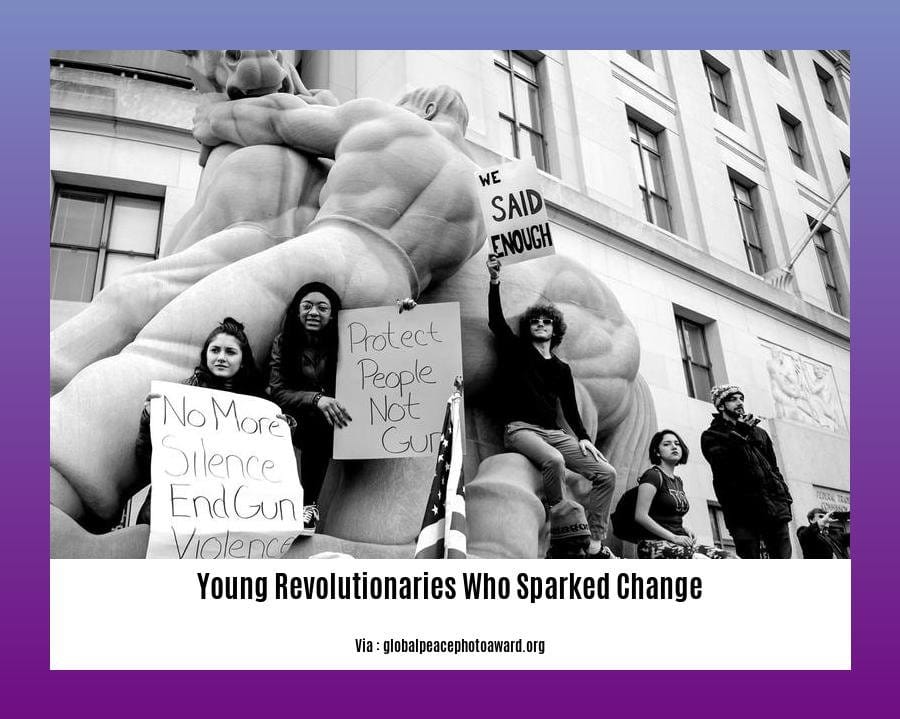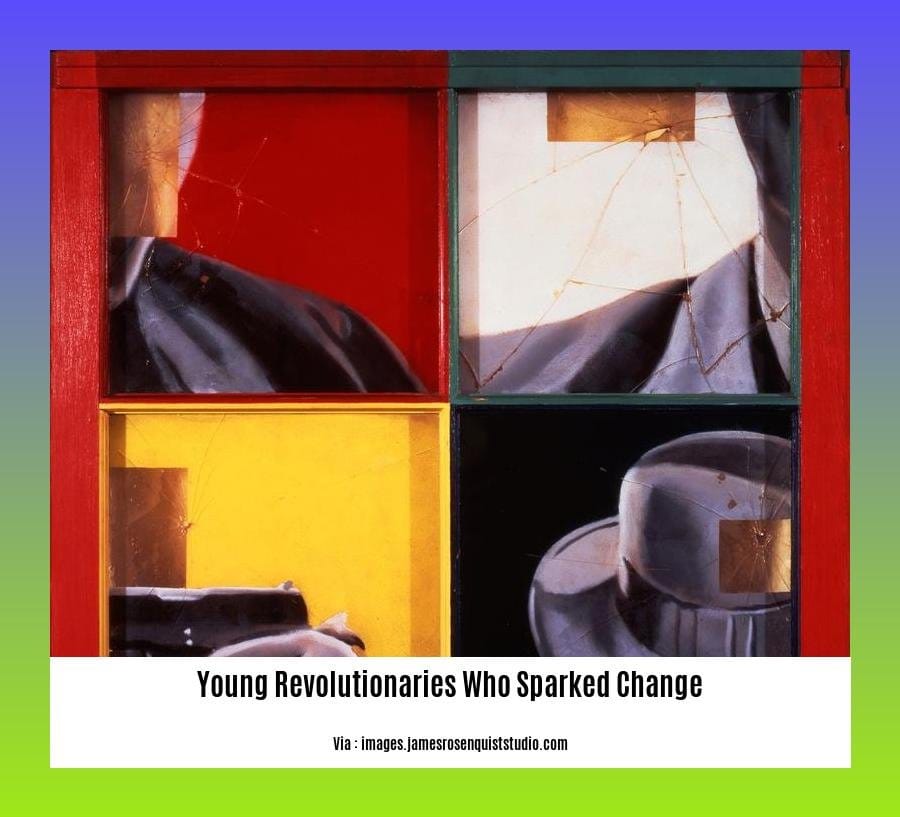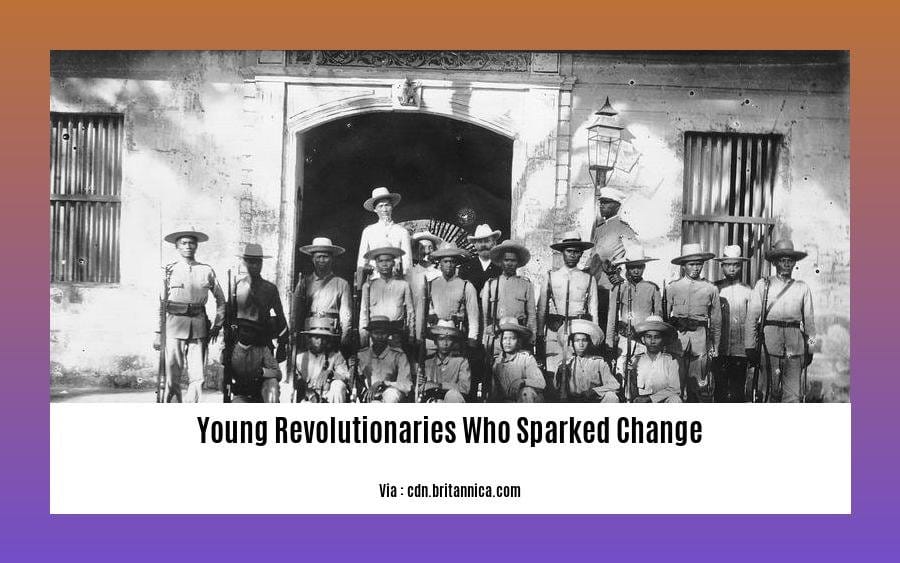Introducing “Young Revolutionaries Who Sparked Change,” an exclusive article that delves into the inspiring journeys of young activists throughout history. From the Civil Rights Movement to present-day youth activism, this piece explores the transformative power of young people who defied convention and ignited profound societal change. Through firsthand accounts and expert analysis, we uncover the motivations, challenges, and triumphs that shaped these revolutionaries, showcasing their unwavering determination and lasting impact on the world.
Key Takeaways:

- Young people, particularly girls, have consistently led social change movements in the United States throughout history.
- Youth activists have made significant contributions to movements ranging from labor rights to climate change.
- They have challenged conventional leadership and embraced grassroots organizing to achieve their goals.
- Notable examples of influential young activists include:
- Sybil Ludington (American Revolution)
- Civil rights activists
- Anti-nuclear disarmament protesters
- Women’s liberation movement participants
- Black Lives Matter activists
- Climate change advocates
Young Revolutionaries Who Sparked Change
Young people have frequently served as catalysts for social change in the United States. They have demonstrated the potency of grassroots organizing and questioned traditional leadership structures.
Examples of influential young revolutionaries:
During the American Revolution, Sybil Ludington led a perilous midnight ride, much like Paul Revere, to call for soldiers.
Young activists played significant roles in the civil rights movement. Ruby Bridges, a six-year-old, faced hostility and death threats as the first African American child to integrate an all-white school in 1960.
Anti-nuclear disarmament protests: High school students, inspired by 15-year-old Swedish activist Greta Thunberg, staged strikes and protests to demand action on climate change.
Women’s liberation movement activists: Gloria Steinem, a prominent feminist author and activist, has been instrumental in raising awareness about gender inequality and spearheading the fight for reproductive rights.
Black Lives Matter activists: Young activists like Alicia Garza, Patrisse Cullors, and Opal Tometi co-founded the Black Lives Matter movement to mobilize against racial injustice and police brutality.
These young revolutionaries who sparked change inspire us. They demonstrate the power of passion, dedication, and unwavering belief in the possibility of a better world. Their energy, audacity, and fresh perspectives can change the establishment and push us toward a better future.
Let these inspiring examples serve as a reminder that age is nothing but a number when you have the audacity to challenge the status quo and ignite change.
Be prepared to be inspired by accounts of youth revolutionary leaders and activists who sparked change. Read about trailblazing young revolutionary figures who were at the forefront of social change. Explore the stories of revolutionary prodigies who sparked movements and left an enduring legacy.
Youth Activism: Shaping a New Era of Social Change
Key Takeaways:
- Surging Youth Activism: Young people are increasingly becoming agents of social change.
- Alter-Activism: Emphasizing lived experiences and collective action.
- Impactful Challenges: Climate change, abortion rights, gun violence.
- Resilience and Tenacity: Young activists face obstacles but press on.
- Collective Action: Young people harness the power of community to drive change.
Youth activism has emerged as a formidable force in the contemporary landscape. Young people are stepping up like never before, challenging the status quo and pushing for a more just and equitable world.
The Rise of Alter-Activism
A new era of activism has dawned, marked by the rise of Alter-Activism. This approach prioritizes lived experiences and the interconnectedness of social issues. Young activists are weaving their personal narratives into their activism, creating a powerful tapestry that resonates with a diverse audience.
Tackling Critical Issues
Youth activism is addressing pressing issues of our time. From climate change to reproductive rights, young people are leading protests and advocacy efforts that demand attention. Their voices are being heard in government halls and shaping public discourse.
Challenges and Perseverance
The path of Youth Activism is not without obstacles. Young activists face criticism, skepticism, and even backlash. But they remain undeterred, fueled by a deep-seated passion for change. Their resilience and tenacity serve as an inspiration.
Collective Action: The Power of Unity
Young activists recognize the power of collective action. They are joining forces across generations and backgrounds, forming alliances that amplify their voices. By leveraging social media and grassroots organizing, they are mobilizing young people to make a difference.
Conclusion
Youth Activism is not merely a trend; it is a testament to the indomitable spirit of young people who are committed to shaping a better future. Their passion, creativity, and unwavering belief in change will continue to be a catalyst for social transformation.
Most Relevant URL Source:
- The Role of Youth Activism in Facilitating Social Change: A Conceptual Framework
Youth Revolution 1960S
Fasten your seatbelts, history buffs! We’re going back in time to the groovy 1960s, where young people took center stage, fueling social and political change. Buckle in for this ride as we discover the power of Youth Revolution 1960S.
Key Takeaways:
- Young people have historically been changemakers, leading movements for social justice, equality, and peace.
- The 1960s witnessed a surge in youth activism, fueled by a desire for change and a frustration with the status quo.
- Iconic movements like the Civil Rights Movement, the Vietnam War protests, and the counterculture movement were shaped by the passion and determination of young activists.
Civil Rights Movement
Imagine the courage of young people like John Lewis, Diane Nash, and Bob Moses, who defied segregation and discrimination in the Jim Crow South. Their sit-ins, marches, and Freedom Rides shook the nation, paving the way for the Civil Rights Act of 1964.
Vietnam War Protests
Thousands of young people took to the streets to protest the Vietnam War, questioning the government’s motives and demanding an end to the conflict. Their voices, amplified by music and art, helped shape public opinion and influence the eventual withdrawal of U.S. troops.
Counterculture Movement
The 1960s also witnessed the rise of the counterculture movement, a youth-driven rebellion against traditional values, materialism, and authority. Young people embraced alternative lifestyles, psychedelic drugs, and rock music, challenging societal norms and inspiring a new era of social change.
Youth Empowerment
The Youth Revolution 1960S demonstrated the incredible power of young people to shape history. They proved that age is not a barrier to activism and that their voices deserve to be heard.
Citation:
- National Geographic: Youth in Revolt: Five Revolutions Started by Young Activists

FAQ
Q1: What role did youth activists play in the Civil Rights Movement?
Q2: How did young activists use technology to their advantage in the fight for social change?
Q3: What are some of the challenges that young activists face today?
Q4: How can we support and empower young activists?
Q5: What are the key lessons we can learn from the youth-led social movements of the past?
- Revolution Space: Disruptive Ion Propulsion Transforming Satellites - April 24, 2025
- Race Through Space: Fun Family Game for Kids - April 24, 2025
- Unlocking the Universe: reading about stars 6th grade Guide - April 24, 2025
















